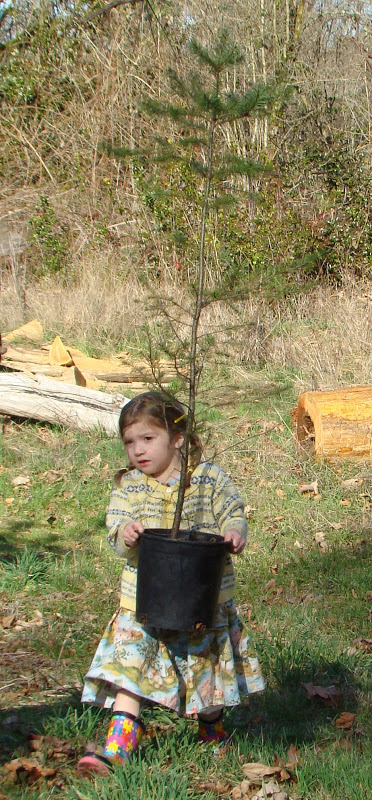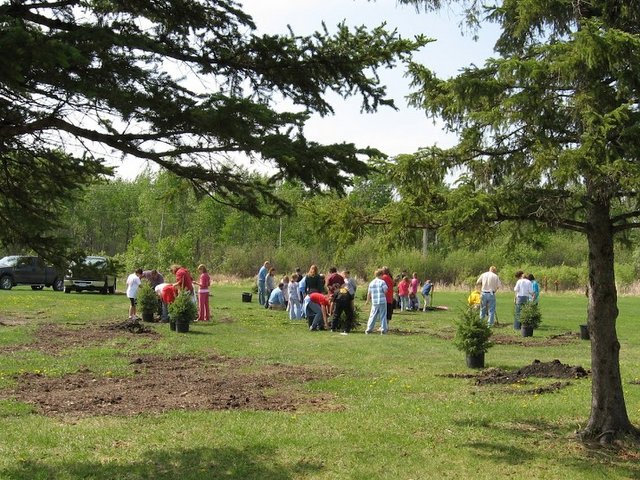Trees provide some amazing services! They produce the air we breathe, they provide food and other resources many species need to survive, they offer wind and noise breaks, they control erosion and storm water runoff, and they reduce excess carbon dioxide in the atmosphere.
Express your appreciation for trees on Earth Day, Arbor Day (and every day) by planting a tree at your school or in your community. Here is a little more inspiration and some tips to get you started.
To get you into the tree planting mood, listen to “These Trees” by Billy B from his CD, Billy B Sings About Trees, co-produced with Project Learning Tree.

Looking for more activities for exploring nature with young children?
Trees & Me, our newest activity guide for educators and families of ages 1-6, includes more downloadable music by Billy B. and sound samples with scannable QR codes direct to specific tracks.
Take a listen to Track 11 and get kids moving and learning about the environment. Trees & Me also includes special considerations and ideas for taking activities outdoors, no matter your setting!
Choose wisely
What kind of tree would you like to plant?
One that flowers, one that provides fruit to eat, one that has leaves which turn red, orange, or yellow in the fall, one that stays green all year long, one that grows taller than all the rest, or one that prefers to stay small?
 When choosing a tree to plant, pick one that you like but make sure it will thrive in your local environment. Native species will be easier to care for since they are already well adapted to your region, climate, and other conditions. Check out the Arbor Day Foundation’s “Best Tree Finder Wizard” to help you identify your ideal tree.
When choosing a tree to plant, pick one that you like but make sure it will thrive in your local environment. Native species will be easier to care for since they are already well adapted to your region, climate, and other conditions. Check out the Arbor Day Foundation’s “Best Tree Finder Wizard” to help you identify your ideal tree.
Also be sure to check out our Plant a Tree free activity for ages 10-16 from our Learn About Forests Toolkit, adapted from Project Learning Tree’s PreK-8 Environmental Education Activity Guide, which can be obtained through an in-person professional development workshop or online course.
Location, location, location!
Did you know all trees have different preferences for the amount of light, water, and other resources they need to survive?
Choose your site carefully by researching what your chosen tree needs to grow. Then, select a location that provides the resources your tree needs.
Be sure to plant your tree away from buildings, power lines, fences, and other structures. This will ensure that your tree has enough space to grow.
Timing is everything
Well, not exactly everything, but timing is very important! Typically, April and May are the best times to plant most trees in the U.S. September and October also work well for some species of trees. By planting trees in the spring or fall, you’ll ensure that your trees can establish themselves when the weather is cool and the soil is moist, avoiding stressful conditions when the weather is harsh in the summer and winter.
Taking care of your tree in its early years will also help your tree thrive. Be sure to water your tree and protect it so that your community can enjoy the tree for many years to come.
Mulch madness
 If you are planting a tree in your yard or in a public space, consider using mulch around the base of the tree (but take care not to have the mulch touching the tree trunk).
If you are planting a tree in your yard or in a public space, consider using mulch around the base of the tree (but take care not to have the mulch touching the tree trunk).
Mulch can help your tree retain water, protect it from extreme temperatures, and prevent other plants from outcompeting your tree for resources.
Follow the ‘rule of three’ for mulching:
- 3 foot diameter of mulch
- 3 inches deep
- 3 inches out from base of the trunk
Water and wait!
Your new tree will need water when it is first planted. Follow these rules of thumb for watering your tree while it expends a great deal of energy getting established. How much water your tree needs will also depend on the species. Be sure to research the recommended amount of water your chosen tree will need when it is first planted.
As the tree gets older, you should not need to continue watering. Once its roots are well established, the tree should be able to withstand a range of environmental conditions.
♫ Put that tree in the ground, water it and wait.
Water and wait, water and wait, water and wait, water and wait.
And as that tree grows give it care,
so it will thrive and grow when you’re not there.
Yes, as that tree grows tall and strong
you can watch it grow all your life long! ♫
More resources
- Want to plant a tree as a classroom project? Check out Activity 31, Plant a Tree in PLT’s PreK-8 Environmental Education Activity Guide
- Login to access the activity’s Student Pages, with tree planting tips for students available in English and Spanish



7 comments on “Tree Planting Tips”
We are excited to be planting new trees in our yard. Thank you for informing me that timing is important and plays a big role on tree growth success. Something else to consider would be making sure the soil is prepared and ready when the trees take root.
I want to plant some trees in my yard to replace some dead ones. Thanks for the advice about how you should choose the tree that will do well in your environment. Another thing to consider is to get a tree service to advise you on the best place to put trees.
I never knew that different trees had different preferences for amounts of light, water, and other resources. If someone is planting a tree soon, then they might want to learn about the trees recommended light exposure. If a tree has too much light then it might not be healthy, and the same if it has too little light.
Great advice, I will have to check out the activity guides.
Great tips here. Thanks for sharing great and useful tips!
Thanks for going over some tree planting tips. I actually didn’t know that mulch could help protect the tree from extreme temperatures. This sounds like it could be really useful if you live in an area where the temperature changes often. It could be good to learn more about how often this mulch should be applied, especially if there are special circumstances that may need more mulch.
Great advice! You’ve covered all the major necessities of having fruitful trees! Pun intended!